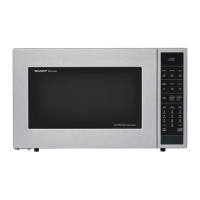ABOUT YOUR MICROWAVE OVEN
This operation manual is valuable: read it carefully and
always save it for reference.
NEVER use the microwave oven without the turntable
and support nor turn the turntable over so that a large
dish could be placed in the microwave oven. The turn-
table will turn both clockwise and counterclockwise.
ALWAYS have food in the microwave oven when it is
on to absorb the microwave energy.
When using the oven at power levels below 100%, you
may hear the magnetron cycling on and off. It is normal
for the exterior of the oven to be warm to the touch when
cooking or reheating.
Condensation is a normal part of microwave cooking.
Room humidity and the moisture in food will inu-
ence the amount of moisture that condenses in the
oven. Generally, covered foods will not cause as much
condensation as uncovered ones. Vents on the oven back
must not be blocked.
After using convection, automatic mix or broil, you will
hear the sound of the cooling fan. The fan may continue
to operate as long as 5 minutes, depending on the oven
temperature.
Be aware that, unlike microwave-only ovens, convection
microwave ovens have a tendency to become hot during
convection, automatic mix and broil cooking.
The oven is for food preparation only. It should not be
used to dry clothes or newspapers.
Your microwave output is rated 900 watts using the
IEC Test Procedure. In using recipes or package direc-
tions, check food at the minimum time and add time
accordingly.
ABOUT MICROWAVE COOKING
• Arrange food carefully. Place thickest areas towards
outside of dish.
• Watch cooking time. Cook for the shortest amount
of time indicated and add more as needed. Food
severely overcooked can smoke or ignite.
• Cover foods while cooking. Check recipe for sug-
gestions: paper towels, wax paper, microwave plastic
wrap or a lid. Covers prevent spattering and help
foods to cook evenly.
• Shield with small at pieces of aluminum foil any
thin areas of meat or poultry to prevent overcooking
before dense, thick areas are cooked thoroughly.
• Stir foods from outside to center of dish once or twice
during cooking, if possible.
• Turn foods over once during microwaving to speed
cooking of such foods as chicken and hamburgers.
Large items like roasts must be turned over at least
once.
• Rearrange foods such as meatballs halfway through
cooking both from top to bottom and from right to
left.
• Add standing time. Remove food from microwave
oven and stir, if possible. Cover for standing time
which allows the food to nish cooking without
overcooking.
• Check for doneness. Look for signs indicating that
cooking temperatures have been reached.
Doneness signs include:
- Food steams throughout, not just at edge.
- Center bottom of dish is very hot to the touch.
- Poultry thigh joints move easily.
- Meat and poultry show no pinkness.
- Fish is opaque and akes easily with a fork.
ABOUT SAFETY
• Check foods to see that they are cooked to the United
States Department of Agricultureʼs recommended
temperatures.
145˚F - Fish.
160˚F - Pork, ground beef/veal/lamb, egg dishes
165˚F - For leftover, ready-to-reheat refrigerated,
and deli and carry-out “fresh” food. Whole,
pieces and ground turkey/chicken/duck.
To test for doneness, insert a meat thermometer in a thick
or dense area away from fat or bone. NEVER leave the
thermometer in the food during cooking, unless it is
approved for microwave use.
• ALWAYS use potholders to prevent burns when
handling
utensils that are in contact with hot food.
Enough heat from the food can transfer through
utensils to cause skin burns.
• Avoid steam burns by directing steam away from
the face and hands. Slowly lift the farthest edge of a
dish’s covering and carefully open popcorn and oven
cooking bags away from the face.
• Stay near the microwave oven while it’s in use and
check cooking progress frequently so that there is
no chance of overcooking food.
• NEVER use the microwave oven for storing cook-
books or other items.
• Select, store and handle food carefully to preserve its
high quality and minimize the spread of foodborne
bacteria.
• Keep waveguide cover clean. Food residue can cause
arcing and/or fires. See page 32.
INFORMATION YOU NEED TO KNOW
8
E

